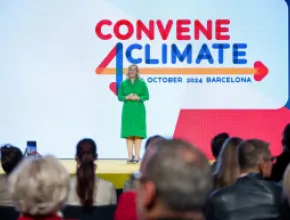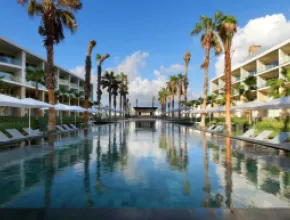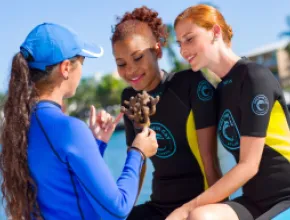When you factor in its many parks, preserves and golf courses, Florida seems very green indeed. But in ways that concern many meeting planners—sustainable practices, environmental impacts and carbon footprints—how does the Sunshine State measure up?
Pretty well, according to data from the Tallahassee-based Florida Department of Environmental Protection (DEP), which oversees the Florida Green Lodging Program, a voluntary initiative recognizing hotels and resorts that make a commitment to conserving and protecting Florida’s natural resources.
The latest figures show 689 designated Florida Green Lodging Properties, and in order to qualify properties must implement a specified number of environmental practices in five areas of sustainable operations: communication and education; waste reduction, reuse and recycling; water conservation; energy efficiency; and indoor air quality.
Green Thumbs
“[The program] is growing at a decent pace,” says Brad Stombock, the DEP’s director of sustainable initiatives.
However, he acknowledges that the number of properties applying for and reaching Green Lodging status has declined somewhat during the recession, a trend he expects will reverse in the near future.
“I believe that as our economy continues to pick up, we’ll see more hotels come in,” Stombock says, noting also that the DEP has expanded its system of “palm” designations to potentially include more properties, implementing a four-tiered point system that will allow more hotels to apply for Green Lodging status, even if at the lowest level. “They can come in at any level they choose. Of course, we’d love to see folks come in at a higher impact, but we still want to recognize those who come in at all.”
He says there are a lot of very small changes that people can make that either cost very little or cost nothing at all.
“We’re not asking them to replace all their heating and cooling systems,” he says. “Just things like, if you replace your incandescent bulbs, please use the CFL [or spiral] bulbs.”
Additionally, the program has been revamped to include regular follow-ups or “spot audits,” as Stombock calls them.
“It used to be that once a hotel was designated, they went off into the sunset and we never heard from them again,” he says. “Now we’re keeping track of their progress and maintenance. We contact them and schedule the audit for two weeks later. It gives them enough time to comfortably accommodate our visit, but it’s not enough time for them to correct any issues they may have.” PageBreak
However, following a number of spot audits, Stombock says he and his team have been pleasantly surprised by the number of properties that have remained in compliance of Green Lodging requirements.
“We’ve only had a handful that haven’t met the standard,” he says.
On the flip side, Stombock says there are hotels that go above and beyond the DEP’s Green Lodging specifications, implementing ingenious practices to save on energy and water.
“One of the larger hotels in our program worked with chemical companies to find a detergent that works at a lower temperature, so they’ve gone from a 180-degree water temperature to 140 degrees, and it saves them a ton of money,” Stombock says. “We know other properties that implement rainwater collection initiatives to use that water for landscaping.”
Stombock says another way properties are watering more efficiently is by using drip lines that send water directly into the root zone.
“It allows them to directionally water the plant,” he says. “A lot of places you see using sprinklers, what they’re really doing is watering the pavement.”
Spinning Green into Vacation Gold
To that end, Sandestin Golf and Beach Resort in Northwest Florida irrigates nearly a quarter of its 2,400-acre property with reclaimed water, while a huge on-site recycling program includes tons of cardboard, newspaper and plastics, scrap aluminum and copper, unused soap and even old tennis balls.
Sandestin has a host of other green initiatives, including a new resort transportation system estimated to reduce fuel consumption by nearly two-thirds, but they’re hardly alone in being environmentally aware. A number of Florida properties have implemented similarly creative green and sustainable practices, including The Breakers in Palm Beach, which maintains its own organic herb and vegetable garden, landscapes using native plants, and has constructed an on-site deep well and water facility for reverse osmosis irrigation.
In addition, Breakers conference specialists work with groups to integrate such green practices into their programs as self-serve water stations and reusable glassware rather than plastic bottles; purchasing renewable energy credits to offset electricity usage; and reducing paper waste by offering electronic storage devices for conference materials and presentation outlines.
In Southwest Florida, SunStream Hotels and Resorts does its part for the environment by supporting the Adopt-A-Road program in Lee County, gathering team members to help clean sections of local roads.
“It’s become a fun, feel-good monthly event that we are proud to be part of,” says Stefanie Eakin, SunStream’s marketing account planner.
SunStream properties Bellasera and DiamondHead are part of the Florida Green Lodging program but all SunStream hotels and resorts are committed to environmental issues, Eakin says.
“This past Earth Day, our properties gave an Acts of Green pledge to find ways to improve the environment and become more eco-conscious,” she says.PageBreak
The Peabody Orlando has found myriad ways to become more eco-aware, developing an algorithm that calculates the cost of “carbon neutral” meetings, adding more natural light to its meeting space and committing to sustainability through its on-site restaurants; Peabody chefs purchase locally grown and organic products whenever possible, including organic and biodynamic wines and fair trade coffees, creating a truly farm-to-fork dining experience.
The Peabody also maintains ChargePoint electric vehicle chargers in its self-parking garage for guests driving electric vehicles, a measure also taken last year by the Hampton Inn & Suites at the Sarasota Bradenton International Airport, which added an electric station capable of charging four electric/hybrid cars.
Turtle Tracks
Meanwhile, other hotels keep sea turtles in mind when it comes to environmental practices, including the resorts lining the sands along Florida’s Space Coast.
“This is the world’s second- largest turtle nesting area, and we get hundreds of turtle nests during the season,” says Rob Varley, executive director of the Space Coast Office of Tourism. “Our hotels have to maintain a certain type of lighting, because otherwise the turtles and the hatchlings will go toward the light and not the ocean.”
In Northwest Florida, new deck areas at the Hilton Sandestin Beach Golf Resort & Spa were designed to minimize disturbances to nesting sea turtles, their hatchlings and other coastal wildlife. The resort also installed more than $250,000 in habitat-friendly lighting to protect sea turtles and other waterfront animals, and planted more than 30,000 new sea oats to protect the dunes.
Also supporting sea turtle conservation is the B Ocean Fort Lauderdale, and plush toy turtles (available for purchase) are left on guest beds as a reminder. A portion of the proceeds benefits sea turtle conservation organizations.
Clean Marinas
Together with the sunshine and palm trees, Florida is defined by water. With more than 1,350 miles of coastline and 50,000 miles of inland and coastal rivers, not to mention countless lakes and springs, clean water is absolutely essential to the state’s $56 billion tourism industry, which includes activities like swimming, boating and fishing.
As with the Florida Green Lodging Program, the DEP maintains a Florida Clean Marina Program, another voluntary designation initiative designed to increase awareness of environmentally friendly practices, though the challenges to meet the standards can be quite different, Brad Stombock of the DEP notes.
“Marinas have issues with fueling, storm water run-off, storage tanks, painting. It all depends on what kind of facility they have,” he says.
According to DEP figures, there are 263 Clean Marinas in Florida, or about 14 percent of all marinas, along with 38 Clean Boatyards and 17 Clean Retailers throughout the state.
“Marina operators tend to understand that if their water isn’t clean, people aren’t going to use them,” Stombock says. “Both our Clean Marina and Green Lodging programs are the largest in the country. They’re what other states base their programs on.”
Learn more about Clean Marinas at www.dep.state.fl.us/cleanmarina; and Green Lodging at www.dep.state.fl.us/greenlodging, which also has a section devoted to helping meeting planners go green, including tips on selecting a destination and choosing accommodations, venues and environmentally conscious transportation companies, as well as suggestions on how to communicate the meeting’s green goals to attendees.






